A new past for a pandemic future: evolutionary and cultural histories of infectious diseases

Centre for History in Public Health Annual Lecture
Infectious diseases are understood now to be caused by microscopic organisms: bacteria, viruses, protists, and prions. None of these were perceptible to humans before the 17th century, and none could be proven to cause disease before the laboratory revolution of the late 19th century. Yet most of the global pathogens affecting human populations today had histories that go much earlier than these fairly recent scientific horizons.
Pathogen histories are increasingly being newly revealed by genetics, in “family trees” constructed by phylogenetics and ancient DNA recovered from archaeological sites. The question then becomes: How well are these new narratives of pathogen evolution and global distribution synching with the old narratives of disease constructed from human-generated cultural records?
This talk will summarise recent developments from a new approach to epidemiological history that combines these two very different kinds of evidence. The history of plague, leprosy, tuberculosis, and smallpox all reveal new dynamics and turning points. They show that pandemics—hemispherically or globally distributed diseases, whether bacterial or viral—share a common feature: dissemination due to human behaviour. Since genetics is now capable of investigating diseases past, present, and yet to come, it is now time to re-think how we conceive of pandemics.
Speaker
Admission
Contact





